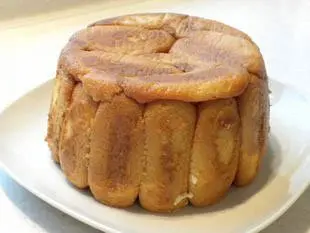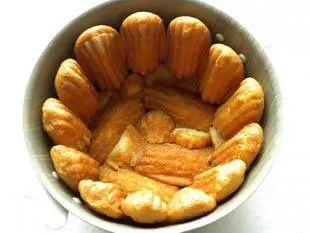The blog of cooking-ez.com
The art of the charlotte

In cooking, a charlotte is a delicious moulded dessert, with biscuits around the outside that have been soaked in a flavoured syrup, filled with a light cream or mousse. The charlotte is left to set in the fridge before being turned out and served in slices.
It is very light and a lovely sweet with which to round off a meal. It is refreshing, too, especially if made with fruit.
It is very light and a lovely sweet with which to round off a meal. It is refreshing, too, especially if made with fruit.
38K 18 4.3
Last modified on: February 27th 2013
The art of the charlotte
Here are some hints on making charlottes.
A charlotte mould is lined in the bottom and around the sides with syrup-soaked biscuits. This outside layer is then filled with a cream and left to set in the fridge (usually overnight).
Of course, it is best to use a proper charlotte mould if possible. This is round and tall with tapering sides which make turning out easier. If the mould is non-stick, so much the better, as there is no need to butter it.
If you are worried that the charlotte will not turn out properly (it might stick on the bottom and fall apart) you can put a circle of paper or plastic film in the bottom of the mould.
Boudoir or sponge finger biscuits are the ones most commonly used – they are just right for this. If you don't have any, you can use slices of genoa sponge or brioche.
The biscuits are soaked in the syrup until they have absorbed some of it up before being arranged around the sides of the mould. The syrup needs to be well-flavoured and quite runny so that the biscuits can soak it up easily (a fruit coulis, for example, is thicker, so would need a longer soaking time).
Please note that there is a delicate balance to be struck between biscuits that are too dry or too soggy. Personally, when using a very liquid syrup (such as coffee), I soak the biscuit in the syrup, then take it out and remove the excess by pressing.
It is traditional to line the mould with biscuits arranged vertically around the side, then arrange more biscuits in the bottom. Of course, the biscuits won't be the right shape and will need to be cut to fit to give an even layer.
Once the outer "casing" is in place, this is filled with a cream that should set when cold. This is typically made with gelatin or agar-agar. One of the best results comes from using (about 50/50) whipped cream with something else that contains dissolved gelatine. This other ingredient can be a fruit coulis (fruit purée), custard (crème anglaise), creamy cheese like mascarpone, etc.
You can also make the charlotte in different layers: cream, diced fruit, cream. However you fill it, do be sure to fill the mould full, even round the top a little, as the cream will tend to sink a little as it sets.
You can also finish with a layer of biscuits, so that the charlotte has a complete outer shell. This is simply for appearance and a matter of taste.
Once the cream has been poured into the mould, cover with plastic film and leave to set in the fridge overnight.
Shortly before serving, turn out carefully and slice vertically. Serve the slices laid flat for best effect, surrounded by a coulis, sauce or custard if you wish.
The dessert's origins are uncertain. The name might refer to the British queen Charlotte who was the wife of George III.
Principle
A charlotte mould is lined in the bottom and around the sides with syrup-soaked biscuits. This outside layer is then filled with a cream and left to set in the fridge (usually overnight).
Mould

Of course, it is best to use a proper charlotte mould if possible. This is round and tall with tapering sides which make turning out easier. If the mould is non-stick, so much the better, as there is no need to butter it.
If you are worried that the charlotte will not turn out properly (it might stick on the bottom and fall apart) you can put a circle of paper or plastic film in the bottom of the mould.
Biscuits

Boudoir or sponge finger biscuits are the ones most commonly used – they are just right for this. If you don't have any, you can use slices of genoa sponge or brioche.
Soaking syrup

The biscuits are soaked in the syrup until they have absorbed some of it up before being arranged around the sides of the mould. The syrup needs to be well-flavoured and quite runny so that the biscuits can soak it up easily (a fruit coulis, for example, is thicker, so would need a longer soaking time).
Please note that there is a delicate balance to be struck between biscuits that are too dry or too soggy. Personally, when using a very liquid syrup (such as coffee), I soak the biscuit in the syrup, then take it out and remove the excess by pressing.

It is traditional to line the mould with biscuits arranged vertically around the side, then arrange more biscuits in the bottom. Of course, the biscuits won't be the right shape and will need to be cut to fit to give an even layer.
Cream filling

Once the outer "casing" is in place, this is filled with a cream that should set when cold. This is typically made with gelatin or agar-agar. One of the best results comes from using (about 50/50) whipped cream with something else that contains dissolved gelatine. This other ingredient can be a fruit coulis (fruit purée), custard (crème anglaise), creamy cheese like mascarpone, etc.
You can also make the charlotte in different layers: cream, diced fruit, cream. However you fill it, do be sure to fill the mould full, even round the top a little, as the cream will tend to sink a little as it sets.
You can also finish with a layer of biscuits, so that the charlotte has a complete outer shell. This is simply for appearance and a matter of taste.
Once the cream has been poured into the mould, cover with plastic film and leave to set in the fridge overnight.
Shortly before serving, turn out carefully and slice vertically. Serve the slices laid flat for best effect, surrounded by a coulis, sauce or custard if you wish.
Charlotte?

The dessert's origins are uncertain. The name might refer to the British queen Charlotte who was the wife of George III.
Lasts posts
Toss the salad
When you've finished preparing a salad, green or otherwise, it's usually time to add the dressing and toss. It's often said to "toss the salad", which means to season and mix. Is it easy? Not so easy...2,1115 March 8th 2024
Half milk, half cream
In a multitude of recipes, savoury or sweet, milk is used as the main ingredient, or at least as the main liquid ingredient. Milk is used instead of water, for example, because milk contains a proportion of fat, which adds roundness and softness to the recipe. This mellowness is very pleasant on...2,111 February 27th 2024
Cutting soft cheeses
As you may have already noticed, when you have to use a "soft" cheese in a recipe - their exact name is "soft cheese" - such as Camembert, Munster or Mont d'or, it's not easy to make anything other than thick slices.2,2505 February 20th 2024
It's spinning too fast!
When you need to grate or slice vegetables, you generally use an electric machine that does all the work: a food processor, a mixer with a "slicer" extension or similar. Are these machines really suitable? Generally speaking, yes of course, but there's one criterion that often poses a problem,...5,1155 November 12th 2023
When I was a kid, I didn't like...
Maybe you've already made this strange observation: when you were a kid, there were things you hated, but as an adult it's almost the opposite? For example, you used to hate spinach or chicory, but now you love it?4,7555 November 5th 2023
Other pages you may also like
What is the difference between bakery and patisserie?
This is a question that you may well have asked yourself and which I will attempt to answer. In France the two trades of "boulangerie" (bakery) and "pâtisserie" (patisserie and confectionery) have always been quite distinct, but where exactly do the boundaries lie? .119K 14.1 February 7th 2017
The march forward
When professionals get to work in their kitchen, lab or bakery, they are (if they are conscientious) very sensitive to hygiene and cleanliness. It is impossible for a good baker for example to do a day's work without regularly cleaning the table where he or she works, and it is even more...13K5 June 30th 2021
The skin side of the fish first?
When it comes to cooking fresh fish, if it's filleted with its skin on and you're planning to pan-fry it in a little olive oil, for example, you might ask yourself the following question: Which side, skin or flesh, should come into contact with the pan first?18K4.4 February 13th 2021
The "pith" of the cauliflower
When using cauliflower in a recipe, there is a lot of preparation work at the beginning: removing the leaves, taking the tops or florets, etc. It's a bit tedious, but in the end you're left with the best of the cauliflower, ready to be used in your recipe.8,2094.9 February 5th 2022
Should I believe my oven?
Can you really trust your oven? This is an important question as we are always tempted to take the temperature indicated as gospel truth and, unfortunately, this is rarely very precise. .27K4.6 July 4th 2011
Follow this page
If you are interested in this page, you can "follow" it, by entering your email address here. You will then receive a notification immediately each time the page is modified or a new comment is added. Please note that you will need to confirm this following.
Note: We'll never share your e-mail address with anyone else.
Alternatively: you can subscribe to the mailing list of cooling-ez.com , you will receive a e-mail for each new recipe published on the site.









